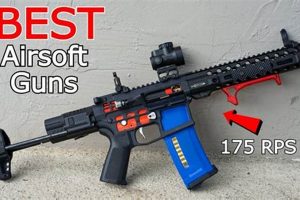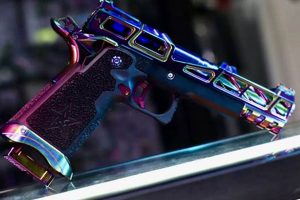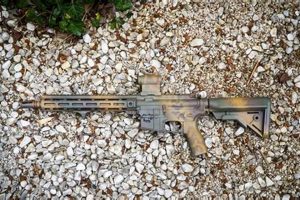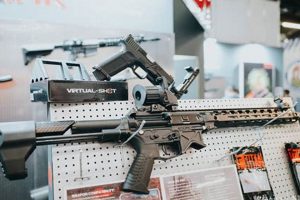These are replica firearms designed to resemble those used in the American Old West, but which fire non-lethal plastic pellets. Often styled as revolvers, lever-action rifles, or shotguns, they offer a recreational activity that simulates historical firearm use in a safe environment. These devices are employed in target practice, historical reenactments, and competitive shooting sports where participants aim to capture the aesthetic of the Wild West.
The appeal of these simulated western firearms lies in their ability to combine historical interest with the action and strategy of skirmish games. They provide an engaging way to experience a bygone era, promoting an understanding of historical weaponry while offering a safe and controlled environment. Their use supports the growth of historical reenactment communities, adding another dimension to the participants’ engagement with the past.
The following sections will delve into the specific types available, the performance characteristics of popular models, the safety precautions necessary for their operation, and the arenas in which enthusiasts commonly utilize this specialized equipment. Understanding these aspects is critical for anyone considering participation in this distinct segment of the airsoft hobby.
Operational Guidelines for Replica Western Firearms
The effective and responsible use of simulated western firearms demands adherence to specific guidelines. These points will enhance both the user’s experience and overall safety.
Tip 1: Prioritize Eye Protection: Full-seal goggles are mandatory when operating these devices. Impact-resistant eyewear shields the eyes from projectile strikes, preventing serious injury. Choose goggles rated to meet or exceed ANSI Z87.1 standards.
Tip 2: Employ Appropriate Projectiles: Utilize only high-quality, seamless, spherical plastic pellets of the correct weight and diameter recommended by the manufacturer. Inferior or mismatched projectiles can damage the device and compromise accuracy.
Tip 3: Adhere to Velocity Limits: Chronograph each device before use to ensure projectile velocity remains within established field limits. Exceeding specified velocity limits increases the risk of injury and may violate field regulations.
Tip 4: Maintain Device Condition: Regularly inspect components for wear and tear. Address any deficiencies promptly by repairing or replacing affected parts. Proper maintenance extends the lifespan of the device and maintains its performance.
Tip 5: Observe Safe Handling Practices: Keep the muzzle pointed in a safe direction at all times. Treat every device as if it is loaded. Avoid pointing the device at anything that is not an intended target.
Tip 6: Secure Transport and Storage: When not in use, transport the devices in designated cases or bags. Store them unloaded, with the gas or battery source removed, in a secure location inaccessible to unauthorized individuals.
Tip 7: Know Field Rules: Familiarize oneself with and adhere to the regulations of the specific venue or organization where the devices are being used. Failure to comply with established rules can lead to expulsion and potential liability.
Adherence to these principles ensures safer operation, extends the longevity of the equipment, and fosters a more enjoyable experience for all participants. Emphasis on safety contributes to a more responsible and accepted form of recreational activity.
The subsequent sections will address specific types of replica western firearms and their suitable applications, further enriching the understanding of this niche hobby.
1. Historical Authenticity
Historical authenticity is a pivotal component in the appeal and functionality of simulated western firearms. The degree to which these devices accurately replicate the appearance, weight, and action of their historical counterparts significantly impacts their value for reenactors, collectors, and participants in western-themed skirmish games. Achieving a high degree of realism necessitates careful attention to detail, encompassing the materials used, the finish applied, and the mechanical operation simulated. For instance, a replica Colt Single Action Army revolver should possess the correct number of chambers, loading mechanism, and grip style to closely resemble the original design. Any deviations from historical accuracy detract from the immersion and overall experience.
Manufacturers often prioritize historical authenticity to cater to specific user groups. Reenactors require accurate reproductions for historical simulations, while collectors value meticulous detail for display and preservation. Even in skirmish games, a desire for historical plausibility can influence the selection of equipment. Examples include simulated Winchester lever-action rifles with realistic cycling mechanisms or replica shotguns with break-open loading actions. These features, while not essential for functionality, contribute significantly to the perceived realism and user satisfaction. Consequently, manufacturers devote considerable resources to researching and replicating historical firearm designs, including the use of period-appropriate materials and finishes.
Ultimately, the pursuit of historical authenticity in simulated western firearms serves to enhance the connection between participants and the historical period they aim to recreate. This dedication to detail not only enriches the experience but also fosters a deeper appreciation for the craftsmanship and technology of the American Old West. However, challenges exist in balancing authenticity with modern safety standards and material constraints. Nevertheless, a strong commitment to historical accuracy remains a defining characteristic of this specialized segment of the airsoft hobby.
2. Mechanical Operation
The mechanical operation of simulated western firearms dictates their performance, reliability, and user experience. Understanding these mechanisms is crucial for informed selection, maintenance, and responsible operation.
- Gas-Powered Systems
Many replica revolvers and rifles employ compressed gas, typically CO2 or green gas, to propel projectiles. This involves a gas reservoir, valve, and nozzle system. Upon trigger actuation, gas is released, pushing the projectile through the barrel. Variations exist in valve design and gas efficiency, influencing power output and shot consistency. CO2 cartridges provide higher power but less temperature sensitivity than green gas. Inaccurate maintenance can cause issues such as gas leakage or valve malfunction.
- Spring-Powered Systems
Spring-powered mechanisms utilize a compressed spring to generate propulsive force. The spring is typically cocked manually, and upon trigger release, it drives a piston that compresses air and launches the projectile. These systems are simpler and more reliable than gas-powered designs, requiring less maintenance. Single-action revolvers and some lever-action rifles commonly employ this mechanism. The trade-off is typically lower power compared to gas-powered variants.
- Hop-Up Systems
The inclusion of a hop-up system significantly impacts the range and accuracy of these devices. Hop-up applies backspin to the projectile as it exits the barrel, generating lift and extending its flight path. Adjustable hop-up units allow users to fine-tune the spin rate to match the projectile weight and desired range. Improper hop-up adjustment can result in under-spin or over-spin, negatively affecting accuracy. Most systems rely on rubber buckings and adjustment dials.
- Loading and Cycling Mechanisms
The realism of replica western firearms is often enhanced by replicating the loading and cycling mechanisms of their historical counterparts. Revolvers may feature functional cylinder rotation and shell ejection, while lever-action rifles may incorporate a lever-operated bolt action. These mechanisms contribute to the immersive experience but can also introduce points of failure if not properly maintained. Complexity varies with design and material quality.
These mechanical facets collectively define the functionality and appeal of simulated western firearms. Understanding the intricacies of gas, spring, and hop-up systems, as well as the nuances of loading mechanisms, contributes to a more informed and rewarding experience. Each mechanism impacts performance, reliability, and overall user satisfaction, making comprehensive knowledge of their operation paramount.
3. Safety Protocols
The operation of simulated western firearms, while recreational, necessitates strict adherence to safety protocols due to the potential for injury. Projectiles, though non-lethal, can cause eye damage, skin abrasions, or other trauma if misused or if inadequate protective measures are in place. A primary cause of injury is the failure to wear appropriate eye protection. The impact of a projectile on an unprotected eye can result in severe and permanent vision impairment. Consequently, the mandatory use of full-seal, impact-rated goggles is a critical safety measure. The absence of such protection creates a direct pathway for injury.
Beyond eye protection, responsible handling and storage practices are paramount. Devices must be treated as if they are loaded at all times, with muzzles pointed in a safe direction. Failure to do so increases the risk of accidental discharge and potential harm to individuals in the vicinity. The improper storage of these items, particularly within reach of children or unauthorized individuals, poses a significant risk of misuse. Safe storage practices, including unloading the device and securing it in a locked container, are essential for preventing accidents. An example of the practical significance of these protocols is evident in organized skirmish events, where strict adherence to safety rules is enforced to mitigate risks and ensure participant well-being.
In summary, the correlation between safety protocols and the responsible operation of simulated western firearms is undeniable. Adherence to established safety measures mitigates the potential for injury, promotes responsible use, and fosters a safer environment for all participants. Challenges remain in consistently enforcing these protocols and ensuring universal compliance. Nonetheless, the commitment to safety remains a cornerstone of this activity and is essential for its continued enjoyment and acceptance. The application of proper safety measures transforms the usage into a secure environment.
4. Ammunition Specifications
The performance and safety of simulated western firearms are directly contingent upon adherence to specified ammunition guidelines. These devices, designed to replicate the appearance and feel of historical firearms, rely on precision-manufactured plastic projectiles for operation. Deviations from recommended projectile specifications can cause damage to the device, compromise accuracy, and, most critically, increase the risk of injury. The compatibility between projectile diameter, weight, and the internal components of the device dictates both its effective range and potential for malfunction. For example, using projectiles that are too heavy for the device’s power source can result in reduced velocity and increased stress on internal mechanisms, potentially leading to component failure. Conversely, projectiles that are too light may result in over-spinning within the hop-up system, causing erratic flight patterns and diminished accuracy. Manufacturers provide explicit guidelines regarding projectile specifications, underscoring their importance for reliable and safe operation.
A practical illustration of the significance of ammunition specifications is observed in competitive skirmish scenarios. Participants who utilize projectiles outside the recommended range often experience a reduction in accuracy and consistency, impacting their ability to effectively engage targets. Furthermore, many organized events implement strict regulations regarding projectile weight and velocity to ensure a level playing field and minimize the risk of injury. Chronographs are commonly employed to verify compliance with these regulations, highlighting the seriousness with which ammunition specifications are treated within the community. The use of substandard or incorrectly sized ammunition can also void warranties and potentially damage the device beyond repair, necessitating costly replacements.
In summary, the interplay between ammunition specifications and the safe and effective operation of simulated western firearms is undeniable. Adherence to these guidelines is paramount for maintaining device performance, minimizing the risk of injury, and ensuring compliance with established regulations. While the temptation to deviate from recommended specifications may arise, the potential consequences outweigh any perceived benefits. A comprehensive understanding of ammunition specifications is therefore essential for anyone engaging with this specialized form of recreational activity, promoting responsible use and extending the lifespan of the equipment.
5. Game Scenarios
The utility and appeal of replica western firearms are intrinsically linked to the diverse range of game scenarios in which they are employed. These scenarios provide a structured context for the use of these devices, transforming them from mere collectibles into tools for interactive storytelling and competitive engagement. The design of these scenarios often draws heavily upon historical events, fictional narratives, and popular culture depictions of the American Old West, providing participants with immersive experiences that extend beyond simple target practice. The selection of specific firearms is frequently dictated by the scenario, with certain models being more appropriate for specific roles and tactical situations. For instance, a sharpshooter scenario may necessitate the use of a replica lever-action rifle equipped with a scope, while a close-quarters saloon shootout may call for a replica single-action revolver. The alignment between the scenario and the equipment is paramount for creating a believable and engaging experience. The integration of authentic costuming and props further enhances the immersive quality, blurring the line between simulation and reality.
A practical example of the connection between game scenarios and replica western firearms can be observed in organized skirmish events that recreate historical battles or fictional encounters from western films. These events typically involve teams of participants who adopt specific roles and objectives, utilizing their equipment and tactical skills to achieve victory. The scenarios often incorporate elements of objective-based gameplay, such as capturing territory, rescuing hostages, or completing specific tasks within a time limit. The rules of engagement are usually tailored to reflect the historical or fictional context of the scenario, with restrictions placed on the types of firearms, ammunition, and tactics that can be employed. A well-designed scenario provides a balanced and challenging experience for all participants, regardless of their skill level or equipment. The level of organization and preparation required for these events underscores the importance of game scenarios in the broader context of simulated western firearms. Such events are commonly observed throughout the American Midwest and Southwest, drawing hundreds of participants and spectators alike.
In conclusion, game scenarios are indispensable for realizing the full potential of replica western firearms. They provide a framework for structured gameplay, historical reenactment, and creative expression, transforming these devices into versatile tools for entertainment and education. The design and implementation of effective scenarios require careful consideration of historical accuracy, tactical balance, and participant safety. While challenges exist in creating consistently engaging and immersive experiences, the ongoing efforts of event organizers and participants alike demonstrate a continued commitment to the development and refinement of these scenarios. The future of simulated western firearms is inextricably linked to the evolution and diversification of game scenarios, offering new and exciting opportunities for enthusiasts to engage with the history and mythology of the American Old West.
Frequently Asked Questions
This section addresses common inquiries regarding the nature, use, and safety of replica firearms designed to resemble those of the American Old West but which employ non-lethal plastic projectiles.
Question 1: What distinguishes simulated western firearms from other types of airsoft devices?
Simulated western firearms are characterized by their deliberate replication of firearms prevalent during the American Old West period. This includes revolvers, lever-action rifles, and shotguns with designs intended to mirror historical models. Other airsoft devices may replicate modern or futuristic weaponry, lacking the specific historical aesthetic.
Question 2: What are the primary safety considerations when operating replica western firearms?
The paramount safety consideration is the consistent use of full-seal, impact-rated eye protection. Additionally, responsible handling practices, including treating the device as loaded at all times and keeping the muzzle pointed in a safe direction, are crucial. Adherence to established velocity limits and the use of appropriate projectiles are also essential safety measures.
Question 3: What types of projectiles are suitable for simulated western firearms?
Only high-quality, seamless, spherical plastic projectiles specifically designed for airsoft devices should be used. Projectile weight and diameter must conform to the manufacturer’s recommendations for the specific device. The use of incorrect or substandard projectiles can damage the device and compromise safety.
Question 4: Are there legal restrictions on the ownership or use of these simulated firearms?
Legal restrictions vary by jurisdiction. It is imperative to research and comply with all applicable federal, state, and local laws regarding the ownership, transportation, and use of airsoft devices. Some jurisdictions may require orange tips or restrict use to designated areas.
Question 5: What is the typical effective range of a simulated western firearm?
Effective range is influenced by factors such as the device’s power source, hop-up system, and projectile weight. Generally, these devices have an effective range of 50 to 150 feet. Precise range will vary depending on the specific model and environmental conditions.
Question 6: How should simulated western firearms be stored when not in use?
These devices should be stored unloaded, with the gas or battery source removed, in a secure location inaccessible to unauthorized individuals, particularly children. Storing the device in a case or bag is recommended for transport and storage purposes.
Understanding and adhering to these guidelines will promote safer operation, extend equipment longevity, and contribute to a more enjoyable experience.
The following section will explore the potential future developments and trends within the simulated western firearm hobby.
Conclusion
The preceding analysis has provided a comprehensive overview of cowboy airsoft guns, encompassing their historical context, mechanical operation, safety protocols, ammunition specifications, and utilization in various game scenarios. The discussion has emphasized the importance of responsible use, adherence to safety guidelines, and compliance with applicable laws. The pursuit of historical accuracy, while a significant factor in the appeal of these devices, must always be balanced with a commitment to safety and ethical conduct.
The future trajectory of the cowboy airsoft guns hobby hinges on continued innovation in design and manufacturing, coupled with a steadfast dedication to promoting responsible gun ownership and usage. As the community evolves, maintaining a focus on safety, historical appreciation, and ethical gameplay will be paramount in ensuring its long-term sustainability and acceptance. Potential consumers should seek further information and training before engaging in said activity.






![Airsoft Legality: Risks of Orange Tip Removal [Guide] Ultimate Airsoft Guide for Beginners, Tactics & Gear Reviews Airsoft Legality: Risks of Orange Tip Removal [Guide] | Ultimate Airsoft Guide for Beginners, Tactics & Gear Reviews](https://airsoftica.com/wp-content/uploads/2025/10/th-990-300x200.jpg)
